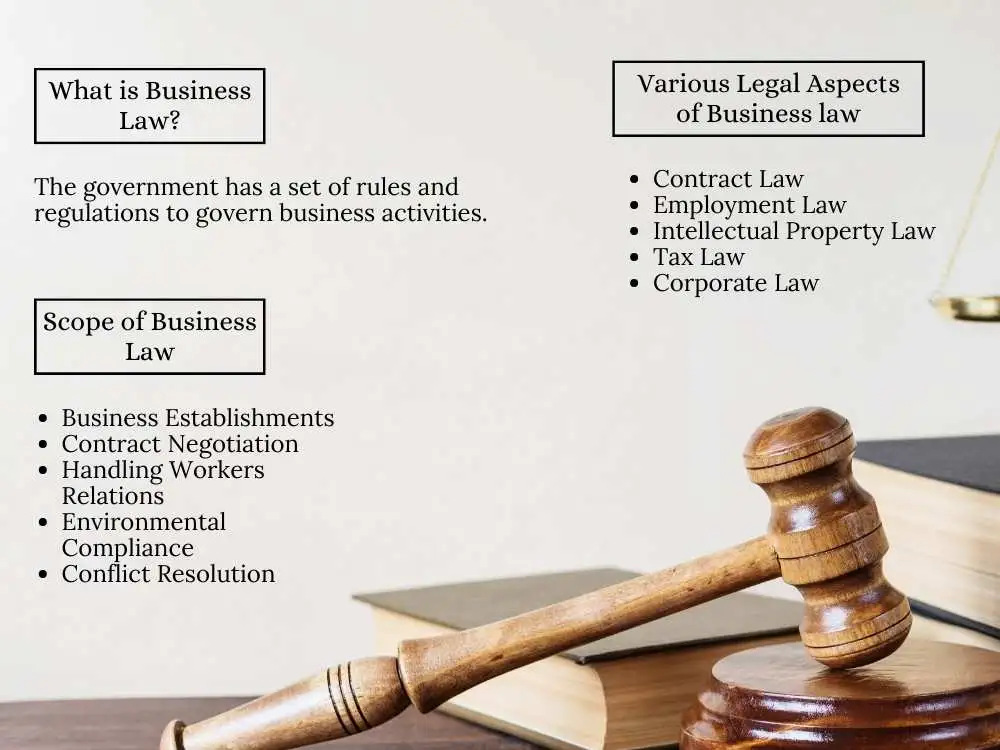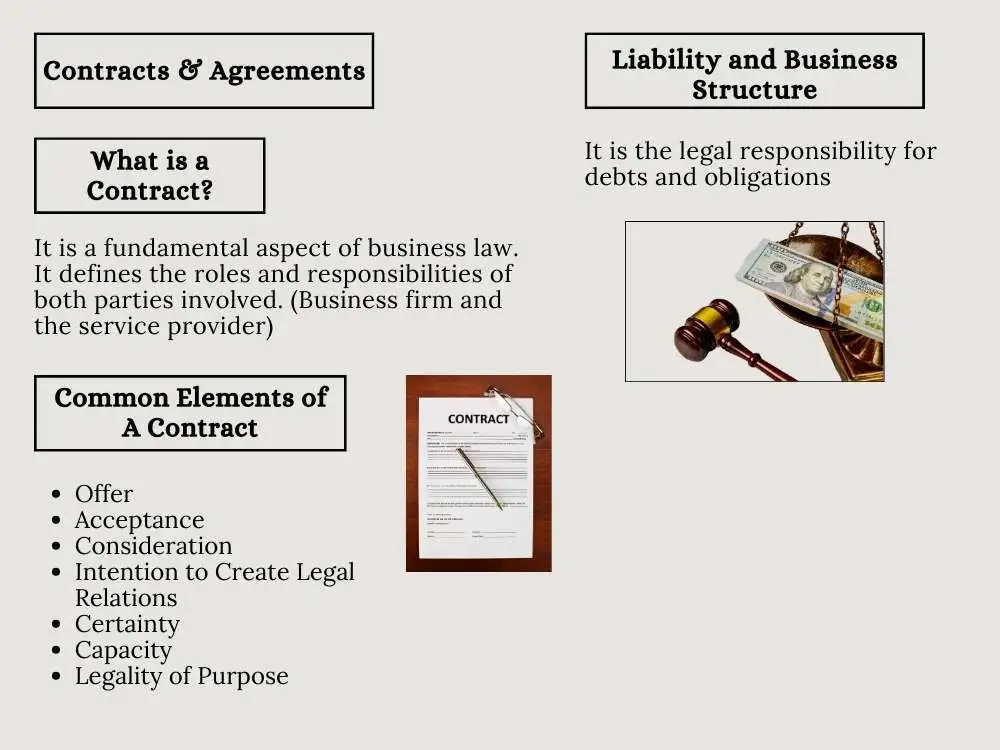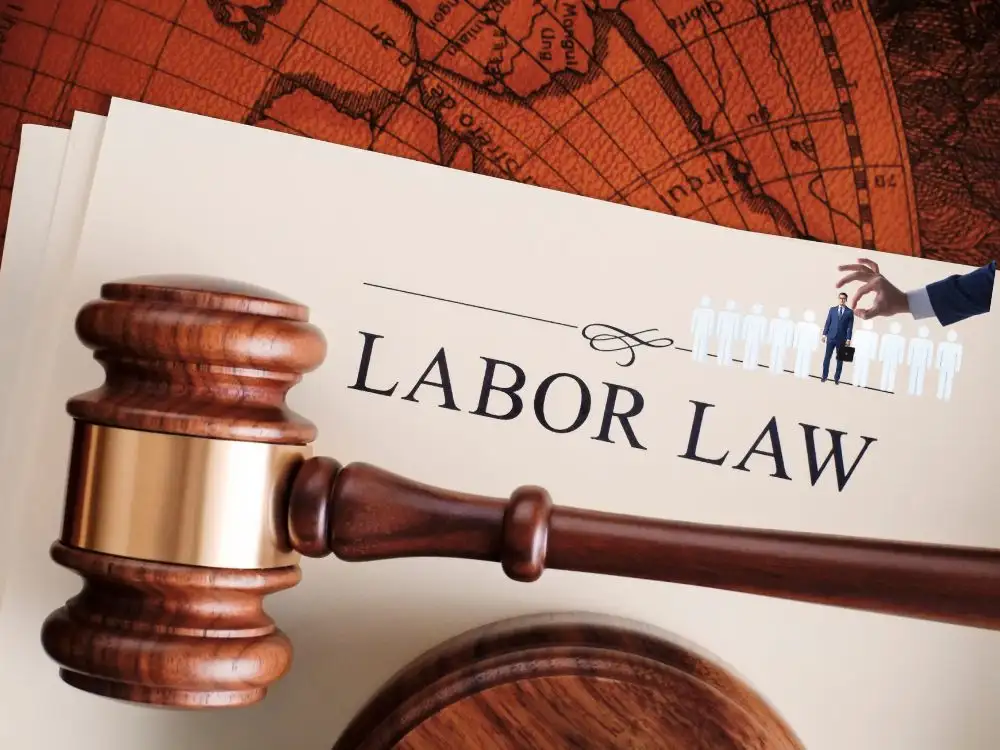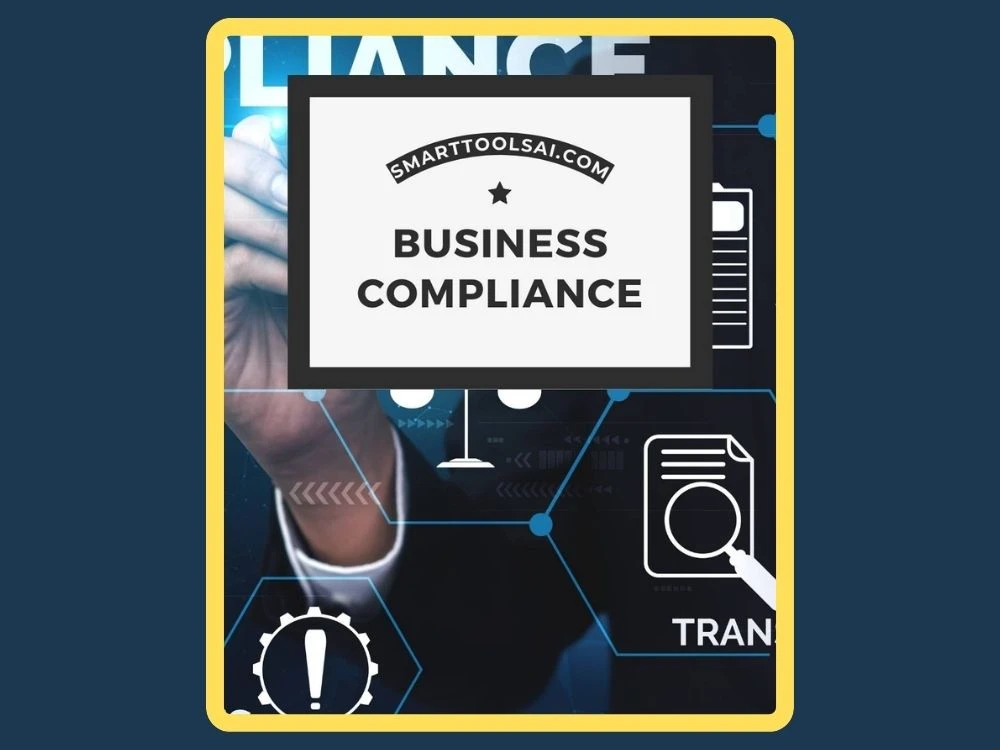
What is Business Law: Crucial Insights for Entrepreneurs
Understanding business law is like having a compass in the corporate world. It's a complete guide to ensure that the business sails smoothly without any major legal problems. It defines the dos and don'ts for different aspects from contracts to copyrights.
Therefore, entrepreneurs must have this knowledge to shield themselves against legal storms. It helps them from unknowingly breaching laws and endangering their venture. Moreover, business law knowledge empowers entrepreneurs to make informed, compliant business decisions.
Key Takeaways
- Understand what business law is, its purpose, and the various legal aspects it covers.
- Learn the key legal principles including contracts & agreements defining rights and obligations and liability shaping financial responsibilities and protections.
- Understand the concept of intellectual property rights including their types and the approaches for securing them.
- Explore critical labor laws and key regulations affecting hiring and firing.
- Know the role of business compliance and regulations including key government regulations.
Understand Business Law

What is Business Law and Its Scope?
To govern business activities, the government has a set of rules and regulations that are identified as business or commercial law. It helps determine how a business entity should function in the industrial market.
Business law has a wide scope that includes certain things such as business establishments, contract negotiation, handling workers relations, environmental compliance, conflict resolution, and so on.
In essence, we find business law as a vital factor in governing business operations with a set of essential rules and regulations.
Various Legal Aspects It Covers in The Business World
There are various aspects a business law covers that help ensure a seamless business operation. Here are some crucial legal aspects it covers:
- Contract Law: This particular law governs legal agreements and obligations between parties like business owners and outsourced service providers or vendors or any other parties.
- Employment Law: This regulates legal aspects between employers and employees. It includes necessary aspects like salary, well-being, discrimination, health & safety, etc.
- Intellectual Property Law: This law protects intellectual property creations such as copyrights, trademarks, and patterns.
- Tax Law: This law ensures tax compliance of businesses on the tax regulations.
- Corporate Law: This law focuses on the formation of corporations and their governance.
Importance of Compliance
Business organizations must comply with the business law rules and regulations. This is a primary requirement for a business to operate and sustain in the market.
As we know, business law covers different aspects of a business and every organization should be aware of complying with the legal aspects. This is vital to reduce any kind of legal consequences and business failures.
Further, businesses that comply with the legal aspects have more advantages in the market. This helps them ensure that the business operates in the legal circle and concerns all business law aspects without any breaches.
Key Legal Principles of Business Law

Contracts and Agreements
Contracts and agreements are among the fundamental aspects of business law. They define the rights and obligations of the parties involved, such as organizations and vendors. These legal instruments are crucial for protecting both parties by clearly establishing terms and conditions.
If one party breaches the agreed terms, the other can seek legal recourse through the courts, potentially leading to compensation or other appropriate consequences. This contractual law effectively boosts compliance and helps run the business with minimal issues.
a) Understanding Contracts and Their Role
It is essential to understand the contracts for a good legal relationship in business. Therefore, both parties engaged in a contract should understand their legal responsibilities, respective roles, and consequences of contract breaches.
This approach serves as a vital foundation to protect the business. Plus it fosters clear communication and fewer disputes.
b) Common Elements of A Contract
A legal contract typically contains some common elements as below;
- Offer: A proposal specifying terms and conditions.
- Acceptance: Agreement to the terms of the offer.
- Consideration: Something of value exchanged by parties.
- Intention to Create Legal Relations: Parties intend for the contract to be legally enforceable.
- Certainty: Clarity and specificity of contract terms.
- Capacity: Legal ability and competence to enter into a contract.
- Legality of Purpose: The contract's objective must be lawful and not against public policy.
Liability and Business Structure
Liability in business means the legal responsibility for debts and obligations. It can be either limited or unlimited. In unlimited liability, business owners are personally responsible for all business debts, while in limited liability, their personal assets are protected.
The business structure that you choose influences the level of liability. Common business structures include sole proprietorships (owned and operated by one person), partnerships (owned by two or more people), corporations (separate legal entities owned by shareholders), and limited liability companies (LLCs), which combine elements of both corporations and partnerships.
Intellectual Property Rights

Protecting Your Ideas and Innovations
This mandatory legal principle protects the ideas and innovations of a business which includes;
- Trademarks: These can be symbols, slogans, or business names
- Copyrights: Original creative works like writings, art, films, etc.
- Patents: This grants exclusive rights for inventions for a specific time
- Trade secrets: These are confidential information of the business that needs protection
How to Secure Intellectual Property Rights
To secure intellectual property rights, business organizations should follow certain steps;
- Documenting the intellectual property
- Choose the relevant protection method
- File required applications to acquire legal protection
- Monitor and enforce business rights against unauthorized uses
- Define rights and responsibilities via contracts and agreements
- Stay updated on relevant laws and regulations for adaptation and changes
- And finally, seek advice from professionals when there are any complications at any stage
Employment and Labor Laws

Hiring and Employee Rights
This is a crucial pillar of business law that necessitates the protection of labor rights and prevents any kind of discrimination based on a person's age, race, color, religion, etc.
This law is paramount to safeguard employee rights such as providing proper workplace, welfare, wages, and good termination policies. Employers cannot merely fire an individual employee based on these discriminatory factors or any other personal issues.
Labor law helps acquire necessary rights from the employer to each worker. Plus, it assists in compensating the employee when a calamity occurs like immediate termination or accident losses.
In addition to this, this law sets a minimum wage for workers that prevents work exploitation. Further, it mandates a safe workplace provision which is important to prevent workplace incidents and related consequences.
Every employee needs to be protected from hazardous occurrences and it is the employers’ liability to ensure this. Also, a proper working schedule, time, and other ethical practices are important to be considered under this law.
Key Regulations Affecting Hiring and Firing
Understanding the importance of key regulations behind hiring and firing is salient. It helps comply with the fair hiring and termination procedures. Here are some essential regulations;
- Anti-Discrimination Laws: During hiring and employment, laws like the Civil Rights Act prohibit discrimination based on race, color, religion, sex, name, or any other origin.
- Equal Employment Opportunity Commission (EEOC) Guidelines: EEOC offers guidelines and enforces federal laws that are related to prohibiting job discrimination.
- Fair Labor Standards Act (FLSA): This regulation governs minimum wage, overtime pay eligibility, recordkeeping, and child labor standards which influence hiring decisions and wage structures.
- Americans with Disabilities Act (ADA): This regulation prohibits any kind of discrimination acts against qualified individuals with disabilities. It requires reasonable accommodations during hiring and employment.
- Family and Medical Leave Act (FMLA): Provides unpaid, paid job-protected leave for specific family or medical reasons to eligible employees.
- Worker Adjustment and Retraining Notification (WARN) Act: This act requires employers to provide notice of plant closings and mass layoffs that affect termination procedures.
- National Labor Relations Act (NLRA): Protects the workers' rights to organize, form, and join labor unions that impact labor relations and potential disciplinary actions.
Business Compliance and Regulations

Government Regulations
Government bodies intervene in business activities in several ways. Regulations are one impactful way that has a great influence on running a business. Let's see some such regulations in detail:
- Internal Revenue Service (IRS): It oversees taxation, tax compliance, and tax incentives for businesses.
- Securities and Exchange Commission (SEC): Properly regulates securities markets and ensures transparency and fair practices in financial transactions.
- Federal Trade Commission (FTC): This regulation protects consumers and enforces laws to promote fair competition and prevent anticompetitive practices.
- Department of Labor (DOL): Responsible for setting and enforcing labor standards, including wages, overtime, and workplace safety.
- Environmental Protection Agency (EPA): Enforces vital regulations related to environmental compliance and sustainability.
- Occupational Safety and Health Administration (OSHA): Sets and enforces workplace safety and health regulations to safeguard employees.
- Department of Commerce: Promotes economic growth, trade, and technological advancement, that assist businesses in various sectors.
- Small Business Administration (SBA): This one provides resources, support, and funding opportunities for small businesses.
Understanding these government bodies and their regulations is a vital part of businesses to operate within the legal boundaries and succeed in a regulated business environment.
Wrapping Up
We can clearly understand the importance of business law and its pivotal part in regulating the business environment. It covers several aspects and ensures compliance with properly running a business.
For long-term success, every business should adhere to business law and its legal framework such as intellectual property law, contract law, employment law, tax law, and corporate law.
Further, government organizations significantly influence business acts by enforcing necessary legal conditions. Plus, complying with all business law aspects offers the finest advantages to the organization.
FAQs
Q1: What is business law?
Business law encompasses the rules and regulations set by the government to govern various aspects of business activities. It serves as a guide for how business entities should operate within the legal framework which covers a wide range of areas such as contracts, employment, intellectual property, and more.
Q2: Why is business law crucial?
Understanding business law is essential for navigating the corporate landscape smoothly. It provides entrepreneurs with a comprehensive guide that ensures their firms operate within legal boundaries.
Q3: What laws are covered under business law?
Business law encompasses various crucial aspects such as contract law, employment law, intellectual property law, tax law, and corporate law.
Q4: What is intellectual property?
Intellectual property refers to the legal protection of a business's creative and innovative assets. This includes trademarks for symbols and business names, copyrights for original works, patents for exclusive rights to inventions, and safeguarding trade secrets-confidential information critical to the business.
.webp)